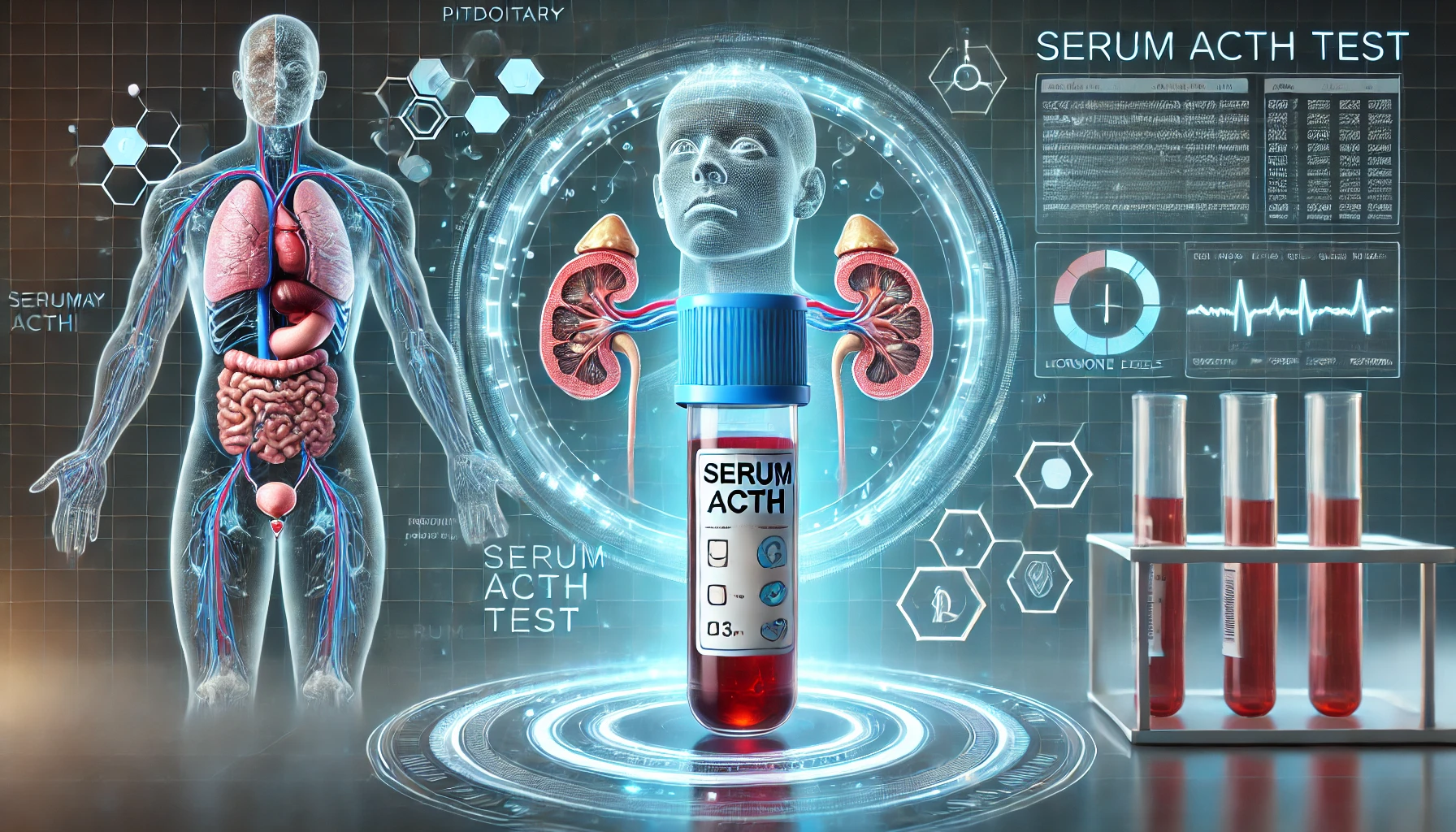
Overview of the Test
The Serum Adrenocorticotropic Hormone (ACTH) test measures the level of ACTH in the blood. ACTH is a hormone produced by the pituitary gland, a crucial gland located at the base of the brain. This hormone plays a vital role in stimulating cortisol production by the adrenal glands, which sit atop the kidneys. Cortisol, commonly referred to as the “stress hormone,” is essential for metabolism, immune response, and stress regulation.
Healthcare providers commonly order the Serum ACTH test to assess the functioning of the pituitary and adrenal glands. It helps diagnose, monitor, and manage conditions such as:
- Cushing’s Disease – Overproduction of cortisol due to excess ACTH.
- Addison’s Disease – Underproduction of cortisol due to adrenal insufficiency.
- Adrenal Insufficiency – Impaired cortisol production due to adrenal or pituitary dysfunction.
- Pituitary Tumors – Growths affecting hormone regulation.
- Ectopic ACTH Syndrome – ACTH production from non-pituitary tumors (e.g., lung cancers).
Function of ACTH in the Human Body
ACTH is a key regulator in the hypothalamic-pituitary-adrenal (HPA) axis, which controls the body’s stress response:
- Hypothalamus Activation – The hypothalamus releases corticotropin-releasing hormone (CRH) in response to stress or low cortisol levels.
- Pituitary Stimulation – CRH signals the pituitary gland to release ACTH into the bloodstream.
- Adrenal Response – ACTH stimulates the adrenal glands to produce cortisol.
- Feedback Mechanism – High cortisol levels signal the hypothalamus and pituitary to reduce ACTH production, maintaining balance.
Cortisol’s Key Functions:
- Regulates metabolism by controlling carbohydrate, fat, and protein usage.
- Modulates the immune system, reducing inflammation.
- Helps the body respond to stress and trauma.
- Maintains blood pressure and cardiovascular function.
- Regulates blood sugar levels by influencing insulin.
Uses of the Serum ACTH Test in Medical Diagnostics
The Serum ACTH test is essential for:
- Diagnosing Hormonal Disorders – Differentiating between primary (adrenal) and secondary (pituitary) disorders.
- Assessing Pituitary Function – Evaluating if the pituitary gland produces appropriate ACTH levels.
- Detecting Adrenal Insufficiency – Identifying adrenal gland dysfunction.
- Monitoring Treatment – Assessing response to therapy for adrenal and pituitary disorders.
- Identifying Ectopic ACTH Production – Detecting non-pituitary tumors producing ACTH.
Reasons for Ordering the Test
Healthcare providers may recommend this test if a patient exhibits symptoms of cortisol imbalance.
Symptoms of Low Cortisol Levels (Adrenal Insufficiency/Addison’s Disease):
- Chronic fatigue and muscle weakness
- Unexplained weight loss and loss of appetite
- Low blood pressure, dizziness, and fainting
- Hyperpigmentation (skin darkening, especially in creases)
- Salt cravings
- Nausea, vomiting, diarrhea, or abdominal pain
Symptoms of High Cortisol Levels (Cushing’s Syndrome):
- Rapid weight gain, especially in the abdomen and face (moon face)
- Purple stretch marks (striae) on the skin
- High blood pressure (hypertension)
- Bone loss (osteoporosis)
- Mood changes, anxiety, or depression
- High blood sugar levels (hyperglycemia)
- Muscle weakness
High-risk groups include:
- Individuals with pituitary or adrenal tumors
- Patients with unexplained hormonal symptoms
- Those with a family history of endocrine disorders
- Patients with suspected ectopic ACTH production from tumors
Test Procedure and Method
Sample Collection:
- Sample Type: Blood sample drawn from a vein (venipuncture).
- Procedure Steps:
- A healthcare provider cleans the puncture site.
- A tourniquet is applied to make veins more visible.
- A needle is inserted into a vein (usually in the elbow or hand).
- Blood is drawn into a collection tube.
- The needle is removed, pressure is applied, and a bandage is placed.
Laboratory Analysis:
- The sample is analyzed using immunoassay techniques (e.g., ELISA or chemiluminescent immunoassay) to measure ACTH levels.
Preparation and Guidelines
- Fasting: Some providers recommend overnight fasting.
- Timing: Blood is drawn in the morning (6–8 a.m.) due to daily fluctuations in ACTH levels.
- Medications:
- Inform your doctor about all medications, supplements, or herbal products.
- Some drugs (e.g., corticosteroids, estrogen, spironolactone) can affect results.
- Stress and Physical Activity: Avoid stress and intense exercise before the test.
- Dietary Considerations: Generally, no specific restrictions unless advised otherwise.
Interpreting Results
Reference Ranges:
- Morning (8 a.m.): 9–52 pg/mL (picograms per milliliter)
- Evening (8 p.m.): <10 pg/mL
High ACTH Levels May Indicate:
- Addison’s Disease – Adrenal glands fail to produce cortisol, triggering high ACTH.
- Cushing’s Disease – A pituitary tumor overproduces ACTH.
- Ectopic ACTH Syndrome – Non-pituitary tumors release ACTH.
- Congenital Adrenal Hyperplasia – Genetic disorders affecting cortisol synthesis.
Low ACTH Levels May Indicate:
- Secondary Adrenal Insufficiency – Pituitary dysfunction leads to inadequate ACTH.
- Cushing’s Syndrome (Adrenal Cause) – Adrenal tumors produce excessive cortisol, suppressing ACTH.
- Long-term Corticosteroid Use – Suppresses natural ACTH and cortisol production.
Clinical Implications and Next Steps
- Confirming Diagnoses – ACTH results help differentiate primary vs. secondary adrenal conditions.
- Treatment Planning:
- Medications – Hormone therapy for deficiencies, inhibitors for excess cortisol.
- Surgery – Tumor removal (pituitary, adrenal, or ectopic sources).
- Radiation Therapy – Treating tumors when surgery is not viable.
- Further Testing:
- MRI or CT Scans – Imaging of the pituitary and adrenal glands.
- Stimulation or Suppression Tests – Evaluating gland responsiveness.
- Ongoing Monitoring – Regular testing ensures treatment effectiveness.
Frequently Asked Questions
- How accurate is the Serum ACTH test?
- Highly accurate when performed correctly, but time of day, stress, and medications may influence results.
- Are there risks associated with the test?
- Risks are minimal, with possible mild pain, bruising, or dizziness at the blood draw site.
- How long do results take?
- Typically available within a few days to a week.
- Why is morning testing recommended?
- ACTH follows a diurnal rhythm, peaking in the early morning.
Final Thoughts
The Serum ACTH test plays a critical role in diagnosing and managing hormonal imbalances. If you have symptoms of cortisol imbalance, consult your doctor for proper interpretation and next steps. Regular monitoring and medical guidance are key to effective treatm
